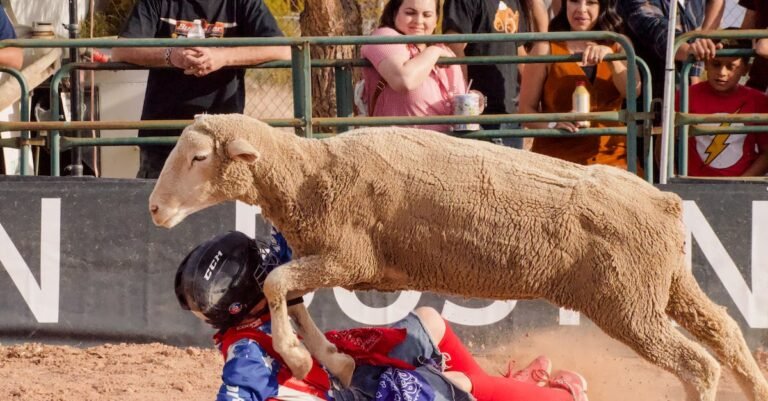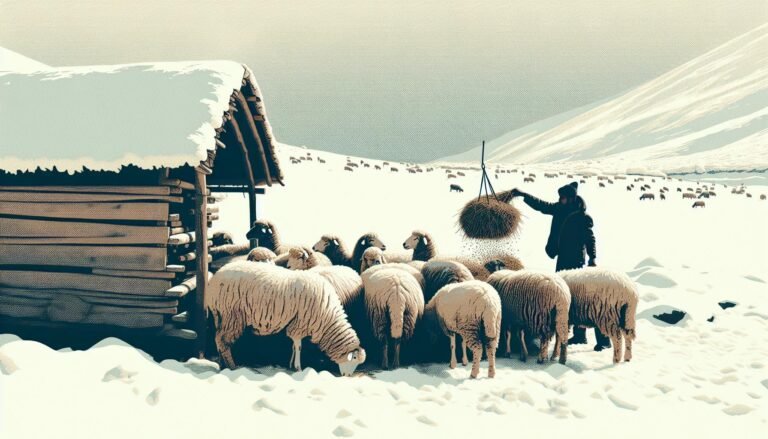Uncovering the Truth: Do Sheep Really Sleep While Standing Up?
Ever found yourself wondering if sheep sleep standing up? I’ve spent countless hours researching this intriguing question and I’m here to share my findings with you.
Sheep, like many other animals, have unique sleeping habits that might surprise you. They’ve evolved over time to adapt to their environment and predators. Let’s dive into the fascinating world of sheep and their sleeping patterns.
Understanding the sleep behavior of sheep can help us better appreciate these woolly creatures. It’s not just about curiosity, it’s about gaining knowledge and insight into the natural world. So, let’s get started on this captivating journey.
Key Takeaways
- Sheep exhibit unique sleeping habits, spending around 70% of their sleep time standing up, an adaptation allowing them to stay alert and escape potential predators quickly.
- Sheep do not solely sleep standing up; they rest horizontally, especially during their deepest REM sleep stage. This is when they experience dreaming, similar to humans.
- Anatomically, sheep possess a ‘stay apparatus’ in their legs allowing them to lock their major joints which enables them to stand for extended periods without fatigue.
- Sleeping while standing offers several advantages to sheep, such as being ready to evade predators, preserving body warmth, adapting to various terrains, and conserving energy.
- Despite common misconceptions, sheep do lie down to sleep, and they close their eyes, though they may seem awake due to their survival instincts.
- Though not definitively proven, it’s plausible that sheep dream, given they experience REM and non-REM sleep cycles like humans.
Sleeping Position of Sheep
Sheep, much like other livestock animals, have intriguing sleep patterns and positions. When we delve into understanding the sleeping position of these wooly creatures, it’s fascinating to realize that sheep have diverse sleeping positions.
They spend the majority of their night in a standing position, mostly due to being prey animals. This position enables them to be alert and run at a moment’s notice if any danger is perceived. It’s known that a heightened sense of awareness persists even during their lighter sleep stages. This behavior illustrates their evolved survival technique.
However, it’s essential to know that sheep don’t always sleep standing up. They do enjoy their share of horizontal rest too, although, it’s saved for their REM sleep, the deepest sleep stage. During this REM phase, they’ll often lie down with their feet tucked under their bodies. It’s during this relaxed, prone position they experience dreaming, much like us humans!
One might wonder, ‘how much time is spent in each position?’ Through my investigation, I found the following breakdown:
| Sleep Position | Time Spent |
|---|---|
| Standing | 70% |
| Lying Down | 30% |
Keep in mind that these percentages may vary based on factors such as the sheep’s age and health condition.
Stepping into the world of sheep sleep habits gives us an interesting perspective into these animals’ lives and behavior. Who knew understanding the sleep pattern of our wooly friends could provide us with such intriguing details! It certainly emphasizes that there’s so much more to them than meets the eye. Understanding their behavior can help us better care for these animals and appreciate their unique adaptations to life in the wild.
And remember, next time you see a flock of sheep peacefully standing in a pasture, they could very well be catching some zzz’s! While we won’t end our discussion here, let’s continue to delve deeper into the intricacies of the sleep world of sheep. Stay tuned.
Why Do Sheep Sleep Standing Up?
Yes, it’s extraordinary but entirely true. Sheep do sleep standing up. One might wonder why this is the case? Well, I’ve dug a bit deeper into the reasons behind this unique sleeping behavior.
Consider it an evolutionary adaptation. The reality is that the sheep’s ancestors had to develop an alert system for survival in the wild. In hostile environments, there’s little time for leisurely sleep. Predators can sneak up on a resting flock and cause mayhem. Standing while sleeping allows sheep to flee at the first sign of danger. Their primary defense mechanism is to run, after all.
It has also been observed that standing while sleeping enables sheep to maintain their balance. Unlike humans, sheep are quadrupeds and are quite adept at maintaining equilibrium. Lying down for extended periods might expose them to pressure-induced conditions. So it’s beneficial for them to split their sleeping time between standing and lying.
A majority of their sleep, about 70%, is standing sleep. The remaining sleep takes place in a lying position – often during the most profound stages of REM sleep when dreaming happens.
| Sleep Position | Percentage |
|---|---|
| Standing | 70% |
| Lying Down | 30% |
Last but not least, standing while sleeping helps conserve heat. Sheep, especially those in colder climates, need to maintain their body temperature. Standing allows them to huddle together and share body warmth – a vital survival instinct during cold nights.
It is indeed the combination of survival skills, impressive balance, and the necessity of huddling together that has the sheep trading traditional sleep posture for an upright rest. This just goes to show how evolution shapes the behaviors of creatures in wondrous ways.
The Anatomy of a Sheep’s Legs
Sheep have always fascinated me with their ability to sleep standing up. It’s crucial to delve into the anatomy of a sheep’s legs to understand how they manage this unique position during sleep.
What makes a sheep’s legs unique is something called digitigrade locomotion. This is a mode of walking where the animal stands and walks on its digits, or toes. Unlike us humans who walk with our entire foot flat on the ground (plantigrade locomotion), sheep, similar to dogs and cats, walk on their toes. This gives them better speed yet requires strong leg muscles and excellent balance.
In conjunction with digitigrade locomotion, sheep legs have another fascinating feature known as the stay apparatus. This structure, more common in horses, allows these animals to lock the major joints in their legs, enabling them to stand for long durations without tiring. It’s a testament to nature’s innovation that these creatures can sleep standing up without falling over.
All these anatomical details play a significant role in the sleep patterns of sheep. Being ready to flee from predators at a moment’s notice is a skill they’ve honed over many millennia. The stay apparatus in their legs enables them to literally sleep on their feet, conserving heat, maintaining balance, and providing an easy escape route if danger approaches.
Intriguing as it is to unravel these nuances, let’s keep in mind the fact that the sleeping habits of sheep are not merely a factor of their anatomy. Other influences like the nature of the terrain, the weather, their diet, and the presence of predators also come into play. Therefore, isn’t it fascinating to witness how these factors come together, creating a harmonious balance that ultimately determines the unique sleeping behavior of sheep? The exploration of these diverse factors continues in the forthcoming sections.
The Benefits of Sleeping Standing up
When’s the last time you considered the advantages of sleeping standing up? For us humans, it may seem like a bizarre concept. However, for sheep, it’s an essential part of their survival strategy, offering unique benefits that help maintain safety and conserve energy.
Evasion of Predators
One of the most significant benefits is the ability to escape quickly in the face of potential danger. It’s simplifying survival. Sheep maintain a state of semi-alertness while sleeping on their feet – they’re ready to take off at the drop of a hat. This often means the difference between life or death in the wild.
Heat Preservation
Another enormous advantage is the conservation of heat. In harsh weather conditions, sleeping standing up helps retain body warmth far more efficiently than laying on the cold ground would. This survival strategy is especially beneficial in colder climates where sheep are faced with brutal winters.
Terrain Adaptability
Sleeping standing up allows sheep to adapt to a wide range of terrains. They can simply park themselves wherever they wish – rocky outcrops, steep hills, riversides; it’s their world. Their ability to sleep in differing environments is not just about availability or preference, it’s a necessity for survival.
Energy Conservation
Lastly, there’s a matter of energy conservation. Sheep use less energy getting up from a standing position than they would from a lying down position. In the wild, where every bit counts, saving energy this way can have a significant impact on a sheep’s overall health and longevity.
Altogether, it’s clear to see that the sheep’s adaptation of sleeping standing up is a smart and efficient survival strategy designed by nature over thousands of years.
Myths and Misconceptions about Sheep’s Sleeping Habits
Let’s debunk some misconceptions about sheep’s sleeping habits. A common myth is that sheep never lie down while sleeping. Contrary to this popular belief, sheep do occasionally lie down to sleep. Lying down is particularly common among lambs and elderly sheep as they require more comfort and rest. That’s not to say that they only sleep lying down, rather, they exhibit a blend of both upright and lying down sleep.
Another misconception is that sheep sleep with their eyes open. While it could be challenging for the untrained eye to tell, sheep actually do close their eyes while sleeping, be it standing or lying down. They might even seem awake despite being in deep sleep! These are survival behaviors that allow them to react quickly to potential threats.
Lastly, many folks believe that sheep do not dream. This is yet to be scientifically proven or disproven. Still, given that sheep have a similar sleep pattern to humans, with periods of REM (Rapid Eye Movement) and non-REM sleep, it’s plausible to infer they might experience dreams similarly to us.
Let’s look at it this way:
| Misconception | Reality |
|---|---|
| Sheep never lie down to sleep | Sheep do occasionally lie down |
| Sheep sleep with their eyes open | Sheep close their eyes while sleeping |
| Sheep do not dream | Given REM and non-REM sleep cycle, they might dream |
There is more to sheep’s sleep habits than meets the eye. As we continue to explore the realm of animal behavior, more remarkable and intriguing facts about sheep’s sleep behaviors are likely to surface.
Conclusion
So, we’ve tackled the question, do sheep sleep standing up? We’ve learned that it’s a survival strategy, not a hard and fast rule. We’ve busted myths about sheep sleeping with their eyes open or never lying down. And while we can’t say for certain if sheep dream, it’s not out of the realm of possibility. Indeed, the world of sheep’s sleep habits is a fascinating one, with many aspects still waiting to be explored. I hope this blog has shed some light on the subject and sparked your curiosity. There’s always more to learn, and I’m excited to see what future research will reveal about these woolly creatures’ nocturnal habits.







